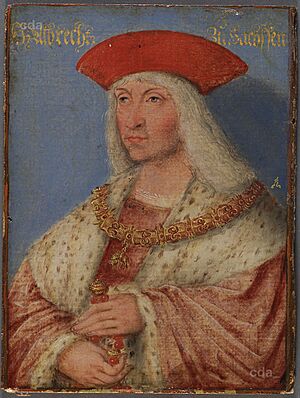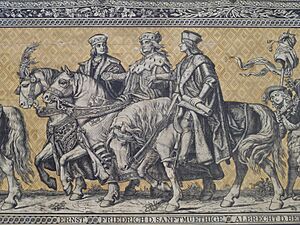Albert III, Duke of Saxony facts for kids
Quick facts for kids Albert III |
|
|---|---|

Portrait by Lucas Cranach the Younger
|
|
| Duke of Saxony | |
| Reign | 7 September 1464 – 12 September 1500 |
| Predecessor | Frederick II |
| Successor | George |
| Margrave of Meissen | |
| Reign | 7 September 1464 – 12 September 1500 |
| Predecessor | Frederick VI |
| Successor | George II |
| Born | 27 January 1443 Grimma |
| Died | 12 September 1500 (aged 57) Emden |
| Burial | Meissen Cathedral |
| Spouse | Sidonie Podiebrad of Bohemia |
| Issue | Catherine, Archduchess of Austria George, Duke of Saxony Henry IV, Duke of Saxony Frederick, Grand Master of the Teutonic Knights |
| House | House of Wettin |
| Father | Frederick II, Elector of Saxony |
| Mother | Margaret of Austria |
| Religion | Roman Catholicism |
Albert III (German: Albrecht) (born January 27, 1443 – died September 12, 1500) was an important Duke of Saxony. People knew him as Albert the Bold or Albert the Courageous. He started a famous family line called the Albertine line of the House of Wettin.
Contents
Life and Times of Albert the Bold
Albert was born in Grimma. He was the third son of Frederick II the Gentle. His mother was Margarete of Austria, who was the sister of Emperor Frederick III. Albert later became a member of the Order of the Golden Fleece, a special group of knights.
When he was young, Albert and his brother Ernest were kidnapped by a man named Kunz von Kaufungen. After they escaped, Albert spent some time at the court of Emperor Frederick III in Vienna.
Marriage and Dividing the Lands
On November 11, 1464, Albert married Zdenka (Sidonie) in Eger. She was the daughter of George of Podebrady, who was the King of Bohemia. However, Albert did not become King of Bohemia when George died in 1471.
After his father passed away in 1464, Albert and his brother Ernest ruled their lands together. But in 1485, they decided to divide their territories. This was done through an agreement called the Treaty of Leipzig. Albert received the region of Meissen and some nearby areas. This is how he founded the Albertine branch of the House of Wettin.
Albert's Military Leadership
Emperor Frederick III thought Albert was a very skilled soldier. In 1475, Albert played a big part in a war against Charles the Bold, who was the Duke of Burgundy.
In 1487, Albert led an army against Matthias Corvinus, who was the King of Hungary. This mission did not go well because the Emperor did not provide enough support.
The War with Hungary
From 1477, a new conflict started with King Matthias Corvinus of Hungary. He began to invade lands belonging to the Austrian Habsburg family. This war is known as the Austrian–Hungarian War (1477–1488). The Emperor struggled to get other German leaders to help with military support.
In 1483, Emperor Frederick had to flee Vienna to the safer city of Wiener Neustadt. By 1485, King Corvinus managed to conquer Vienna. He even called himself "Archduke of Austria." In August 1487, the Hungarians also took Wiener Neustadt.
Duke Albert was then chosen to be the main commander of the entire imperial army. His job was to fight Matthias's famous professional army, known as the Black Army of Hungary. Albert's goal was to win back the lost Austrian lands. However, his army was not well-equipped, making the fight very difficult.
Albert realized that he could not expect much help from the empire soon. He knew the situation in the lands he was defending was getting worse. So, on November 17, 1487, Duke Albert told Emperor Frederick that making a deal with the King of Hungary was the best choice. The war ended with a ceasefire in 1488.
Governor of the Netherlands
In 1488, Albert was made Governor of the Netherlands. He held this position until 1493. He marched with the imperial forces to free King Maximilian from being held captive in Bruges.
When King Maximilian returned to Germany in 1489, Albert stayed behind. He was Maximilian's representative and continued the war against the rebels. Albert successfully brought back Maximilian's power in Holland, Flanders, and Brabant. However, he did not get back all the money he had spent during these campaigns.
Later Years and Legacy
In 1498, Albert was rewarded for his service. Maximilian gave him the title of Hereditary Governor (potestat) of Friesland. But Albert had to use his army to claim this title. He was mostly successful and was visiting Saxony when he heard about a new uprising.
The Duke recaptured Groningen, but he died soon after in Emden. He was buried in Meissen.
Albert was a very strong man and skilled in knightly sports and tournaments. His loyalty to Emperor Frederick and the money he spent on wars sometimes made his people unhappy. However, his time as ruler was a period of good fortune and growth for Saxony.
Family and Children
Albert and his wife Sidonie had nine children:
- Katharina (born 1468, died 1524). She married Duke Sigismund of Austria and later Duke Eric I of Brunswick-Calenberg.
- Georg "der Bärtige" (born 1471, died 1539).
- Heinrich V "der Fromme" (born 1473, died 1541).
- Frederick (born 1473, died 1510). He became the Grand Master of the Teutonic Knights.
- Anna (born 1478, died 1479).
- A child born stillborn (1479).
- Louis (born 1481, died shortly after).
- John (born and died 1484).
- John (born 1498, died shortly after).
See also
 In Spanish: Alberto III de Sajonia-Meissen para niños
In Spanish: Alberto III de Sajonia-Meissen para niños


